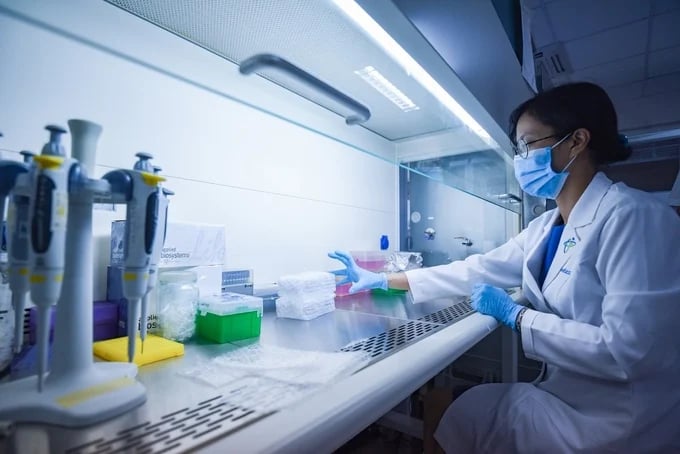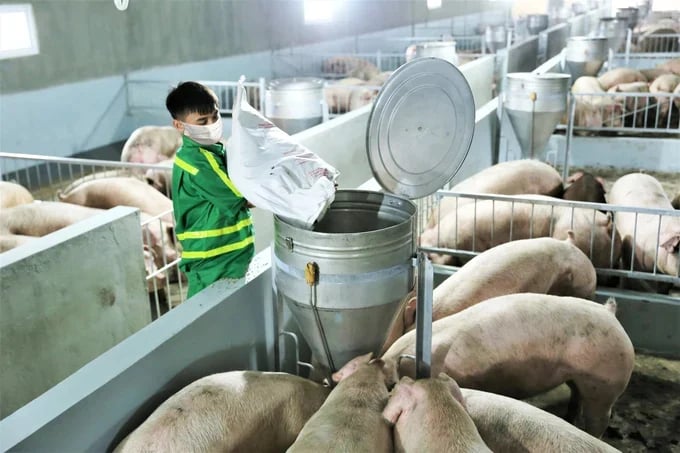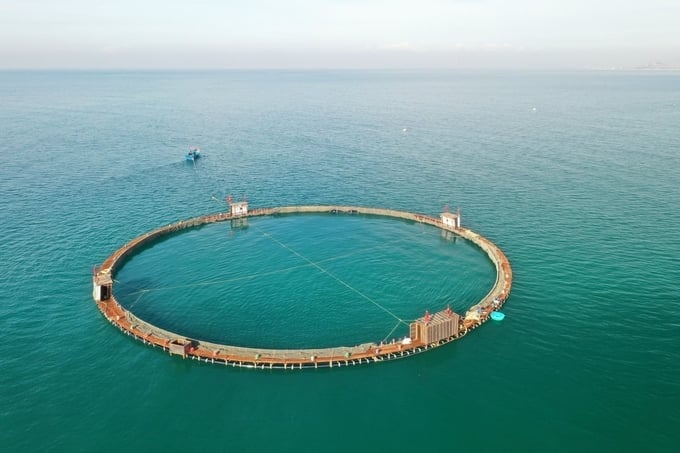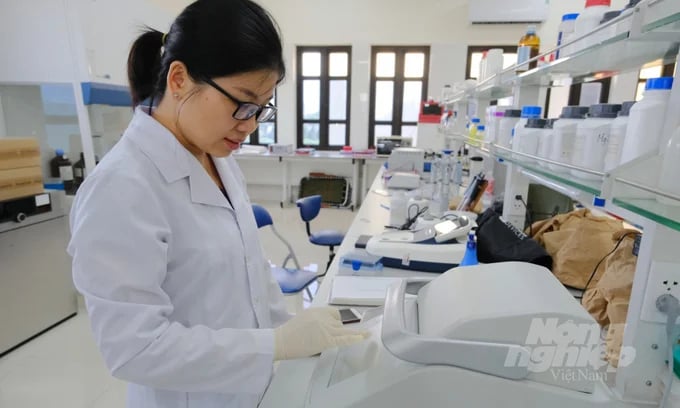May 21, 2025 | 21:17 GMT +7
May 21, 2025 | 21:17 GMT +7
Hotline: 0913.378.918
May 21, 2025 | 21:17 GMT +7
Hotline: 0913.378.918

A forum connecting S&T products, organized by the MARD, aims to address obstacles and encourage the research and transfer of research into production. Photo: Tung Dinh.
On July 10, the Ministry of Agriculture and Rural Development (MARD) will hold a forum to connect agricultural science and technology (S&T) products with businesses, cooperatives, and the public. Minister of Agriculture and Rural Development Le Minh Hoan and Deputy Minister Phung Duc Tien will chair the forum.
Attendees will include leaders of units under the MARD, research institutes, educational institutions, enterprises, cooperatives, and international organizations related to the agricultural sector.
The forum will be organized in a question-and-answer format, directly addressing questions from interested delegates. Reports will introduce the Ministry's policies for encouraging research and innovation in S&T, showcase the results achieved, and highlight successful examples of technology transfer into production.
During the forum, a signing ceremony for the transfer and trade of S&T products will take place, witnessed by Minister Le Minh Hoan, Deputy Minister Phung Duc Tien, and other delegates.
From July 9-10, at the Ministry of Agriculture and Rural Development (No. 2 Ngoc Ha, Ba Dinh, Hanoi), a display area will be organized to showcase outstanding products, technologies, and research results from institutes, educational institutions, and enterprises. Eight display areas will cover fields such as crop cultivation and plant protection; animal husbandry and veterinary medicine; forestry; aquaculture; irrigation and natural disaster prevention; and electromechanics and post-harvest technology.

Mechanization in rice production promotes value chain linkages and meets strict market requirements. Photo: Le Hoang Vu.
In recent years, S&T has significantly contributed to socio-economic development across various fields, including agriculture. S&T applications span all areas, including cultivation, plant protection, animal husbandry, veterinary medicine, aquaculture, forestry, irrigation, and post-harvest technology. These advancements have promoted production, processing, and business by linking value chains and forming closed production areas of modern, large-scale goods that meet strict market requirements.
S&T transfer activities have been robustly implemented across all agricultural fields, helping to reduce investment costs, increase profits, and achieve high economic efficiency in production.
According to statistics, the average growth rate of the agricultural sector over the three-year period from 2021 to 2023 reached 3.35% per year, compared to 2.62% per year during the 2016 to 2020 period.
S&T has been the breakthroughs driving Vietnam's agricultural economy to this success. It is forecasted that agricultural, forestry, and fishery exports in 2024 could reach 60 billion USD. In the field of cultivation, the rate of use of certified (or equivalent) varieties of many crops is quite high.

Large-scale, high-tech pig farming helps create clean, quality products. Photo: QL.
Thanks to the strong application of information technology and biotechnology, the creation of new rice varieties has become more efficient. Today, scientists only need 30 to 50 hybrid combinations to select and create a new rice variety, compared to about 100 hybrid combinations in the past. This efficiency helps shorten the selection time to about 5 years, significantly reducing time and labor while meeting most of the important requirements for rice varieties, such as high yield, good quality, short growth period, good resistance to pests and diseases, and wide adaptability.
Additionally, Vietnamese coffee trees have achieved breakthroughs in productivity, with yields three times higher than the global average. Cashew trees supply about 40% of the total raw materials for Vietnam's cashew processing industry. Vegetable and fruit production has continuously increased in area, productivity, and output in recent years, with diverse and rich varieties.
The impact of S&T in animal husbandry and veterinary medicine is also evident. From 2013 to 2020, the Ministry of Agriculture and Rural Development recognized 42 new livestock breeds, 23 technical advancements, and 19 patented solutions in this field. Currently, 54 high-quality and productive livestock breeds are in production, including 11 new breeds, 12 imported breeds, and 31 hybrid breeds.
The expertise of domestic scientists has significantly improved, as demonstrated by successes in researching and perfecting the processes for producing frozen cattle semen, inducing estrus, and performing artificial insemination for cattle. Additionally, the production of frozen cattle semen in straw form ensures good quality.

East Sea Jumping Squid Joint Stock Company launched the largest sea cage in Vietnam. The project was designed by CEO Nguyen Ba Ngoc and constructed continuously for nearly two months. Photo: Hoang Anh.
Not only that, but the official export of the African swine fever vaccine "Made in Vietnam" to five countries, including the Philippines, Indonesia, Malaysia, India, and Myanmar, is a significant source of pride for the country's livestock industry.
The aquaculture sector has witnessed a strong transformation thanks to the application of S&T. Currently, a variety of high-economic-value aquatic species such as sea bass, yellowfin pompano, mackerel, catfish, loach, sea cucumber, snails, and cold-water fish species have been successfully bred artificially, with farming technology being well-mastered. Despite ongoing challenges in the research and transfer of scientific and technological products, the aquaculture industry has made significant progress. From 2016 to 2023, the sector saw the recognition of 22 new varieties, 28 technical advancements, 13 inventions, and 14 useful processes and solutions.
Thanks to S&T, the fisheries sector has maintained a stable growth rate of 4.5 - 5%. The sector is focusing on reducing fishing and increasing farming, receiving attention from the central government and provincial authorities, who prioritize aquaculture development.
Forestry is also a bright spot in the application of science, technology, and innovation. Recently, the Vietnamese forestry sector has recognized 78 plant varieties, 35 technical advancements, 11 inventions, and useful solutions. The Ministry of Agriculture and Rural Development has acknowledged 11 technical advancements in silviculture and is developing 11 new technical advancements.

Tissue-cultured forestry varieties always ensure disease-free factors, superior productivity, and high wood quality. Photo: BT.
Acacia varieties BV16 and BV523 are just two of a total of 78 new varieties, along with 33 technical advancements and 11 inventions for species such as hybrid acacia, Acacia mangium, Acacia auriculiformis, Acacia triploid, Eucalyptus uro, Eucalyptus hybrid, Eucalyptus pellita, pine, macadamia, Melaleuca five-veined, purple cardamom, sandalwood, and fruit chestnut, which have been recognized by the Ministry of Agriculture and Rural Development and widely planted throughout the country.
In particular, the Acacia AA9 variety grown in the Southeast has a yield of up to 34m³/ha/year, more than three times higher than the conventional variety, equivalent to the yield of hybrid Acacia.
While there are still numerous challenges and obstacles to overcome, developing S&T and fostering innovation are crucial tasks for establishing the foundation and driving force behind the development of ecological agriculture, modern countryside, and civilized farmers.
The contribution of S&T to our country's agricultural development remains limited. In contrast, developed countries attribute over 50% of their agricultural progress to scientific advancements. The application of S&T is not widespread and remains uneven across all stages of production.
Despite the construction of high-tech zones and areas dedicated to agriculture, these facilities have not operated effectively nor attracted businesses to operate within them. There is a lack of a cohesive network and adequate support in these areas.
Additionally, high-tech agricultural processing, aimed at creating added value, continues to face significant challenges. Processing enterprises and agricultural support services have not drawn substantial investment, nor has there been notable technological innovation.

Developing science and technology and fostering innovation are essential to create momentum for sustainable agricultural production. Photo: NNVN.
Science and technology applications in areas such as sustainable resource management, forecasting, warning systems, crop management, and supply chain technologies (like blockchain) are also underdeveloped. Moreover, the development of start-up enterprises in the field of agricultural S&T has not yet achieved the desired results. The application of new technology, innovation, and the development of S&T markets, as well as the research and technology transfer capacity of S&T organizations, remain limited.
Bringing scientific and technological products to the market requires a robust marketing and product consumption network, which heavily depends on the role of enterprises. However, the management staff of scientific career units, currently implementing the autonomous mechanism, often lack the capacity and experience to operate and manage the unit according to the business accounting regime.
More attention should be paid to capturing domestic and international information, especially regarding the needs of production and enterprises, to increase the persuasiveness of S&T products.
In the near future, the Ministry of Agriculture and Rural Development will continue to mobilize investment capital to enhance infrastructure and equipment systems for large-scale research and experimental units. This approach aims to meet development needs more effectively, focusing on modern equipment that is on par with regional and global standards instead of the previous method of small-scale investments for each unit.
Translated by Quynh Chi

(VAN) At the conference to disseminate Resolution No. 68, AgriS introduced its digital agricultural ecosystem and reaffirmed its commitment to accompanying the Government in promoting private sector development and sustainable agriculture.

(VAN) 'Blue Ocean - Blue Foods' initiative is designed to restore marine ecosystems and establish sustainable livelihoods for local communities by cultivating a minimum of 1,000 hectares of cottonii seaweed in the first three years.
/2025/05/21/4642-3-112707_603.jpg)
(VAN) The V-SCOPE project has made direct contributions to three out of six pillars of the Comprehensive Strategic Partnership between Vietnam and Australia.

(VAN) Facing the threat of rabies spreading to the community, Gia Lai province urgently carries out measures to vaccinate dogs and cats on a large scale.

(VAN) Disease-free livestock farming not only protects livestock herds but also stabilizes production and livelihoods for many farmers in Tuyen Quang.

(VAN) Japan's grant aid project contributes to capacity building, promoting organic agricultural production, and fostering sustainable community development in Dong Thap province.

(VAN) For years, the CRISPR-Cas9 genome technology has been reshaping genetic engineering, a precision tool to transform everything from agriculture to medicine.